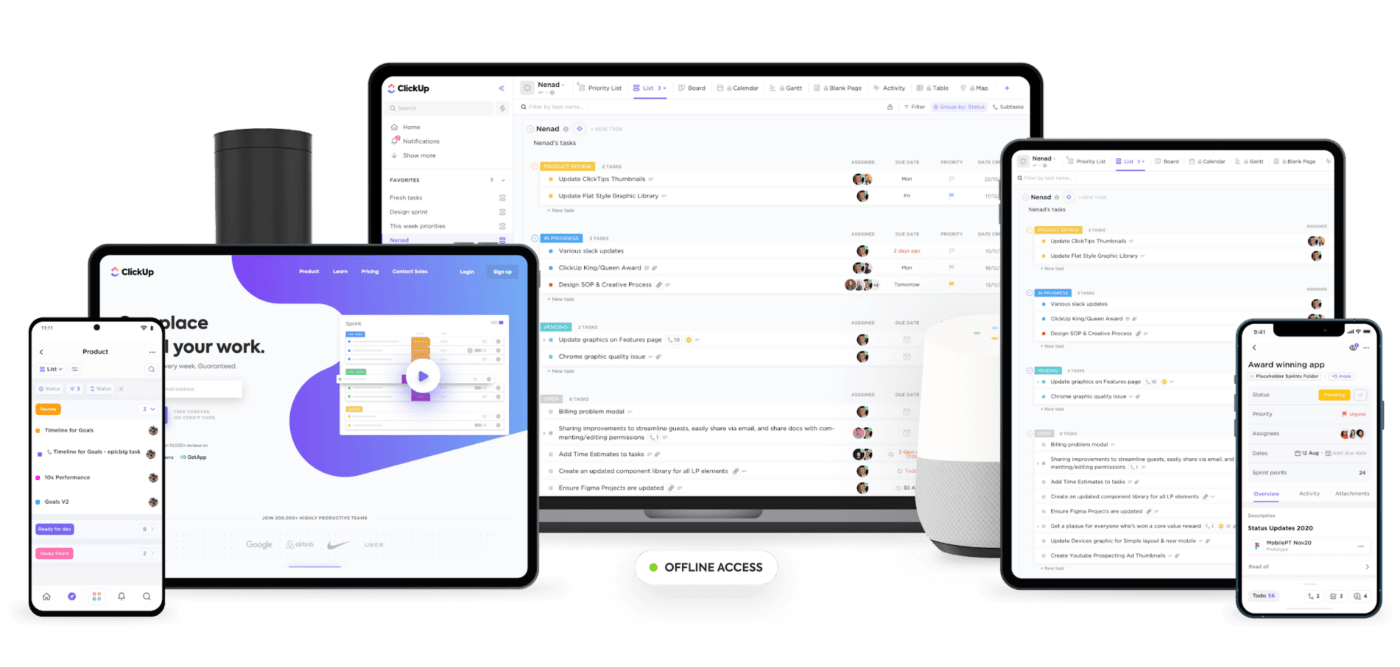كل منتج وخدمة مدفوعة باحتياجات العمل والعملاء المتعددة المعروفة باسم المتطلبات.
ولكن كيف تضمن توافق الناتج النهائي مع جميع هذه المتطلبات؟
الأمر بسيط: من خلال تخطيط فعال لإدارة المتطلبات.
في هذه المقالة، سنستكشف تخطيط إدارة المتطلبات، وسبب أهميته، وكيفية إنشاء خطة قوية لإدارة المتطلبات.
Psst! لدينا أيضًا صفقة سرقة: عرض أداة من شأنها أن تجعل تخطيط إدارة المتطلبات أمرًا سهلاً .
لنضع أقنعة Dalí . 🎭
ما هو تخطيط إدارة المتطلبات؟
يتضمن تخطيط إدارة المتطلبات تحديد كيفية تحديد وتوثيق وتحليل وتنفيذ وتتبع ومراقبة متطلبات المشروع .
دعونا نستخدم تخطيط البروفيسور المضمون من سرقة الأموال للتوضيح
سيكون البروفيسور هو مخطط إدارة المتطلبات. التغييرات التي يتم إجراؤها على خطته أثناء قيام فريقه بسرقة البنك هي المتطلبات. ستغير المتطلبات نطاق المشروع (عملية السطو).
المكافأة:_
_مراجع/ https://clickup.com/blog/product-requirements-document-templates// قوالب_PRD %/%href/_
الآن سيشمل تخطيط إدارة متطلباته التخطيط
- كيف سيحدد التدابير اللازمة لإبقاء خطة السرقة متوافقة مع رؤيته
- كيف سيقوم بتحليل هذه التدابير وتنفيذها
سيتعين عليه أيضًا التفكير في طرق لتتبع ومراقبة متطلبات المشروع المتغيرة باستمرار. بفضل الأشخاص ذوي الطموح المفرط مثل طوكيو في فريقه.

ينطوي تخطيط إدارة المتطلبات على الكثير، بدءاً من تحديد نطاق المشروع وتستمر طوال دورة حياة المشروع.
ولكن، لماذا هو مهم؟
تضمن خطة إدارة المتطلبات تسجيل كل المتطلبات وتحليلها ومعالجتها، بما في ذلك:
- منعك من فقدان مسار الأعمال ومتطلبات أصحاب المصلحة
- السماح للفرق بالتحكم في نطاق المشروع
- التغلب على الأسباب الشائعة لفشل المشروع مثل زحف النطاق، والتأخير في المشروع، وتجاوز التكاليف، وما إلى ذلك.
من المؤكد أن خطة إدارة المتطلبات أمر بالغ الأهمية لإدارة نطاق المشروع.
ولكن كيف يمكنك إنشاء واحدة؟ دعنا نكتشف ذلك.
9 خطوات لإنشاء خطة ناجحة لإدارة المتطلبات ## 9 خطوات لإنشاء خطة ناجحة لإدارة المتطلبات
فيما يلي خطوات التخطيط الفعال لإدارة المتطلبات:
الخطوة 1: تحديد نطاق المشروع ### الخطوة 1: تحديد نطاق المشروع
يتضمن نطاق المشروع تحديد و توثيق أهداف المشروع والمخرجات والمهام والتكاليف والمواعيد النهائية.
ستقوم عادةً بتسجيل نطاق المشروع في إطار خطة إدارة النطاق في ميثاق المشروع أو خطة المشروع. بعد ذلك، يمكنك ببساطة نسخه من هناك.
وبدون خطة إدارة النطاق، سيفتقر أصحاب المصلحة إلى المعلومات الهامة اللازمة لتحديد تغييرات المتطلبات في المشروع. ويصبح من الصعب أيضًا تحديد ما إذا كان يجب عليك تنفيذ أحد المتطلبات المقترحة أم لا.
الخطوة 2: تحديد أصحاب المصلحة في المشروع
يجب أن تذكر خطة الإدارة الخاصة بك الإجراءات التي ستتخذها لتحديدهم.
عندها فقط يمكنك تحديد متطلبات أصحاب المصلحة.
يمكنك عقد اجتماعات أو إجراء مقابلات أو عصف ذهني مع فريقك لتحديد أصحاب المصلحة في مشروعك. ويمكنك حتى اختيار كل صاحب مصلحة إذا لزم الأمر، كما فعل البروفيسور.
الخطوة 3: تحديد الأدوار والمسؤوليات الخاصة بجهود إدارة المتطلبات
يجب أن تحدد خطتك من سيكون مسؤولاً عن جميع جهود إدارة المتطلبات.
يمكن أن يكون مدير المشروع أو محلل الأعمال أو أي عضو آخر في فريقك.
تذكر كيف يعين الأستاذ برلين لتولي مسؤولية الخطة؟

كان مسؤولاً عن جمع ملاحظات الفريق وتحديد ما إذا كانت تلك الأفكار تتماشى مع خطة المشروع.
وبالمثل، ستحدد خطة الإدارة الخاصة بك دور ومسؤوليات الإشراف على عملية إدارة المتطلبات بأكملها.
الخطوة 4: إدارة المتطلبات المتضاربة
من الشائع أن يكون لديك متطلبات متضاربة من مختلف أصحاب المصلحة في المشروع وفريق المشروع الخاص بك.
على سبيل المثال، قد يرغب عميلك في تطبيق يسترجع 1000 سجل مستخدم في المرة الواحدة، في حين أن فريق التطوير قد يجد ذلك غير عملي.
عندما يحدث ذلك، خذ نصيحة من البروفيسور. فقد توقع كل تعارض محتمل بين فريقه والشرطة وخطط لمسار العمل وفقاً لذلك.
وبالمثل، عليك أن تدرج في خطتك كيف ستجعل العميل وفريق التطوير يتفقان على ميزة التطبيق لحل هذا التعارض في المتطلبات.
وبالمثل، قد يتعين عليك أنت ومحللك إجراء بعض التحليلات التجارية لتحديد مثل هذه التعارضات والتوصل إلى اتفاق بين أصحاب المصلحة.
الخطوة 5: وضع استراتيجية لكيفية تحديد أولويات المتطلبات
المشاريع المعقدة لها متطلبات متعددة.
لهذا السبب يجب أن تضع خطة إدارة المتطلبات الخاصة بك منهجية لتحديد أولوياتها. ويشمل ذلك تحديد المتطلبات التي تعتبر مهمة حرجة والتي يمكنك تعيينها للسباق التالي.
على سبيل المثال، مساعدة الفريق على الهروب من الشرطة هو مطلب أكثر أهمية بالنسبة للبروفيسور من جمع كل الأموال النقدية من خزينة البنك.
أثناء تحديد أولويات متطلبات المشروع، يجب أن تأخذ بعين الاعتبار المتطلبات الفنية، وتأثير أصحاب المصلحة، وموافقة أصحاب المصلحة الرئيسيين، وما إلى ذلك، لاتخاذ قرار مستنير.
الخطوة 6: تحديد مصفوفة تتبع المتطلبات
تشير إمكانية تتبع المتطلبات إلى كيفية تتبع متطلبات المشروع طوال دورة حياة المشروع. ويتم ذلك عادةً باستخدام مصفوفة التتبع.
مصفوفة التتبع هي وثيقة تحدد وتتبع متطلبات المستخدم مع حالات الاختبار.
أثناء التعامل مع إمكانية تتبع المتطلبات، يجب أن يكون لديك أيضًا خط أساس للمتطلبات حتى يعرف فريقك ما تم الالتزام به للعميل.
على سبيل المثال، يمكن أن يكون خط أساس المتطلبات في تطوير البرمجيات منتجاً كاملاً تم تسليمه مع مجموعة معتمدة من الميزات.
راجع مصفوفة تتبع ClickUp !
الخطوة 7: إدارة المتطلبات المتغيرة
التغييرات أمر لا مفر منه، بغض النظر عن مدى دقة خطة مشروعك.
كمدير للمشروع، يجب عليك وضع بروتوكول لإدارة المتطلبات المتغيرة عند ظهورها.
لهذا، يمكن أن تحتوي خطة إدارة المتطلبات الخاصة بك على "عملية التحكم في التغيير"
حتى البروفيسور لديه واحدة لا يعرفها سوى برلين.
ستحدد هذه الخطة عملية توثيق أي تغيير. وستتضمن بعض النقاط الرئيسية مثل
- كيف تغير متطلب معين
- سبب قرار إجراء التغيير
- من سيصرح بالتغيير
- ما هو التأثير (إن وجد) الذي يمكن أن يكون له تأثير (إن وجد) على المشروع
الخطوة 8: توصيل متطلبات المشروع
يجب أن يحدد تخطيط إدارة المتطلبات أيضًا آلية توصيل متطلبات المستخدم إلى فريق المشروع وأصحاب المصلحة.
يجب أن تذكر في خطتك ما يلي:
- من سيقوم بإبلاغ الآخرين بالمتطلبات المتغيرة
- من يجب إبلاغه بالتغييرات
- متى يجب إبلاغهم
- كيف يجب إبلاغهم
استخدم البروفيسور كابلًا هاتفيًا للتواصل مع برلين بعد تحقيق كل إنجاز. قامت برلين بدورها بإبلاغ بقية أعضاء الفريق.
الخطوة 9: تحديد أدوات إدارة المتطلبات
أخيرًا، يجب عليك وصف أي أدوات إدارة المتطلبات التي ستستخدمها لتوثيق المتطلبات وتتبعها وإدارتها.
إذا كنت ترغب في تتبع جميع المتطلبات والإشراف على تقدم المشروع، فأنت بحاجة إلى أداة لإدارة المتطلبات مثل ClickUp !

ClickUp هو عالي التصنيف برنامج إدارة المشاريع المستخدم من قبل الفرق المنتجة في جميع أنحاء العالم لإدارة دورات حياة مشاريعهم وتخطيط إدارة المتطلبات.
وباعتباره برنامجاً لإدارة المتطلبات، فهو يجمع فريقك للتخطيط والتعاون في الوقت الفعلي. دعنا نرى كيف:
أ. تتبع التقدم المحرز مع المشاهدات باستخدام ClickUp، يمكنك تتبع المشاريع وخطط إدارة المتطلبات من البداية إلى النهاية من خلال مشاهدات متعددة.
تصور مهامك مع أكثر من 15 طريقة عرض في ClickUp بما في ذلك القائمة واللوحة والتقويم
يمكنك تصور المهام على قائمة , اللوحة أو التقويم عرض
يمكنك أيضا عرض المهام المترابطة أو خطوات خطة إدارة المتطلبات على عرض مخطط جانت البياني وتتبع كيفية تقدم خطتك.
لتخطيط إدارة المتطلبات دون عناء، يمكنك أيضًا الحصول على طرق عرض أخرى مثل: عرض الدردشة .
ومع ذلك، أثناء صياغة خطتك، يجب أن تنتبه إلى بعض الأخطاء الشائعة في تخطيط المتطلبات التي يجب تجنبها.
4 أخطاء في تخطيط إدارة المتطلبات يجب تجنبها
قد يكون تخطيط إدارة المتطلبات صعبًا، خاصة عند التعامل مع مشروع معقد. من الممكن ارتكاب الأخطاء في مراحل مختلفة.
إليك أربعة أخطاء شائعة يمكنك تجنبها كمدير مشروع:
1. التخطيط الخاطئ لأصحاب المصلحة
إذا لم تقم بتخطيط أصحاب المصلحة في المشروع بشكل صحيح، قد ينتهي الأمر بفريقك بالعمل على متطلبات أصحاب المصلحة الخاطئة.

من المهم أيضًا تحديد أصحاب المصلحة بشكل صحيح، حيث أن العديد من متطلبات العمل ستأتي منهم.
2. نقص التواصل
إذا كنت لا تتواصل بشكل جيد مع فريق المشروع والعميل وأصحاب المصلحة، فقد تواجه مشكلة في المتطلبات.
يمكن أن يساعد تواصل الفريق أيضًا في الكشف عن المشكلات مبكرًا لتوفير الوقت والموارد.
بالإضافة إلى ذلك، حتى لو لم يكن لديك ما تقوله، قل ذلك أيضًا.
لا تدع العميل يفترض أن لا شيء يحدث في المشروع.
3. عدم إبقاء الخطة تكرارية
نحن نعلم بالفعل كيف تتغير المتطلبات عدة مرات خلال دورة حياة المشروع.
إذا لم يتم دمج هذه التغييرات، فلن تكون النتيجة ما يريده أصحاب المصلحة.
ومع ذلك، إذا لم تتبع الخطة منهجية تكرارية مثل أجايل، يمكن أن يعلق فريق المشروع بالمجموعة الأولى فقط من المتطلبات.
4. استخدام MS Word و MS Excel للتخطيط
ربما يكون برنامجي Word و Excel أكثر الأدوات شيوعًا التي تستخدمها فرق العمل لالتقاط المتطلبات.
ومع ذلك، مع هذه الأدوات، يمكن أن يصبح إصدار المستندات مشكلة حقيقية.
كما يمكن أن تصبح مصفوفة التتبع التي تم إنشاؤها في ورقة Excel شبكة من الأعمدة التي تشير إلى مستندات لا تنتهي أبدًا. 😰
مكافأة:_
_/مرجع/ https://clickup.com/blog/matrix-templates// قوالب المصفوفة *%/%href/_
3 الأسئلة الشائعة حول إدارة المتطلبات
فيما يلي بعض الأسئلة الشائعة المتعلقة بعملية إدارة المتطلبات:
1. ما هي المتطلبات؟
المتطلب هو أي شيء مطلوب أو مطلوب.
يجب أن يكون ضرورياً ومحدداً ومفهوماً ودقيقاً وممكناً وقابلاً للاختبار.
على سبيل المثال، إذا كان فريق تطوير البرمجيات الخاص بك يقوم ببناء تطبيق لحظر الوقت، فقد تكون ميزة تتبع الوقت أحد المتطلبات.
2. لماذا يجب أن أدير المتطلبات؟
إدارة المتطلبات لا تساعد فقط على تحسين تنظيم مشروعك و الاستراتيجية التشغيلية ولكنها تساعد أيضًا على
- تحسين جودة المنتج أو الخدمة النهائية
- تقليل وقت إنجاز المشروع
- منع تجاوز التكاليف
- تقليل المخاطر
- تمكين الإدارة الفعالة لنطاق المشروع
3. ما هي عملية إدارة المتطلبات؟
تتضمن عملية إدارة المتطلبات ما يلي:
- قوالب جمع المتطلبات :: جمع الملاحظات والاحتياجات من أصحاب المصلحة
- التحليل: تحديد ما إذا كانت المتطلبات الوظيفية المقترحة تتماشى مع نطاق المشروع
- التعريف: توثيق المتطلبات من منظور المستخدم والتقاط المتطلبات الوظيفية أو التقنية
- تحديد الأولويات: تخطيط الإصدارات القادمة أو سباقات السرعة والمتطلبات المطلوبة
- التحقق والصيانة: تحديد ما يمكن تسميته "المتطلبات المكتملة" وتخطيط التحسينات المستمرة
هل أنت جاهز لـ _إعداد خطة قوية لإدارة المتطلبات؟
بالتأكيد، سيستغرق الأمر بعض الوقت لكتابة خطة مثالية لإدارة المتطلبات. فقد كان البروفيسور يخطط للسرقة منذ أن كان عمره 19\. وقد اتضح أنها خطة """رائعة"!
مهما استغرق الأمر من وقت، يجب أن تتحقق خطة إدارة المتطلبات الخاصة بك من جميع الخطوات التي ذكرناها سابقًا.
يمكن أن تساعدك أداة ذكية لإدارة المتطلبات مثل ClickUp على القيام بذلك بسرعة.
فباستخدام ClickUp، يمكنك التعاون وتحرير مستند المتطلبات أو خطة إدارة المشروع، وفرز تعارضات المتطلبات، وتبسيط العمل الروتيني بسهولة.
إنها حقًا الأداة المثالية التي تدعمك في كل خطوة.
_لماذا الانتظار إذن؟ جرب ClickUp مجانًا لإنشاء خطة متينة لإدارة المتطلبات مثلProfessor، ونحن نراهن على أن أصحاب المصلحة لديك سيقولون كلمة واحدة..


